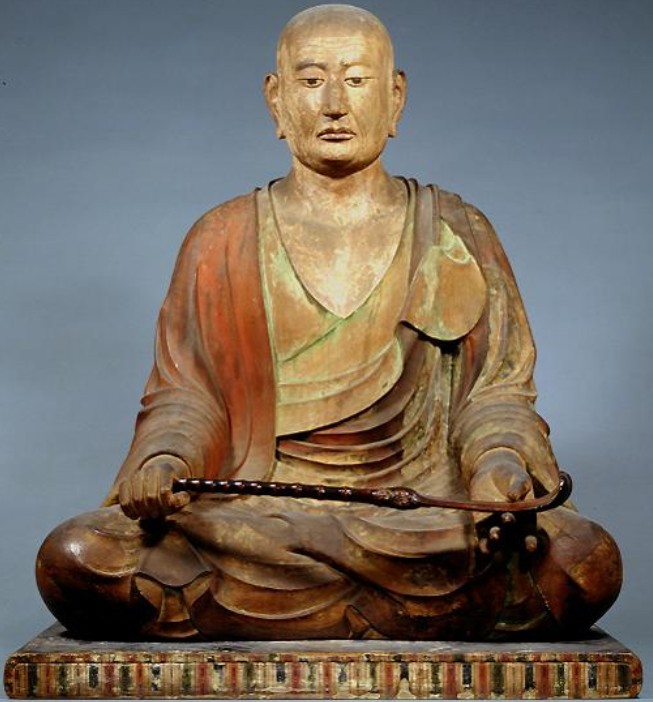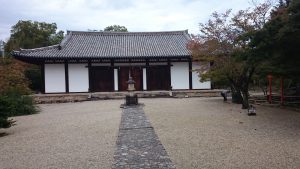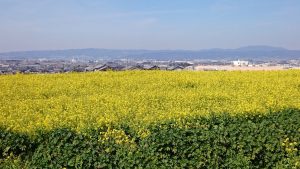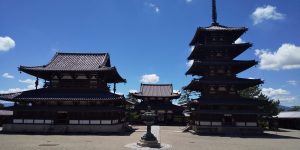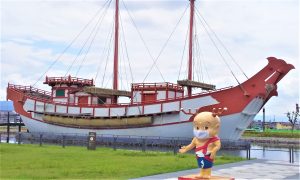興福寺と東大寺 Neighborhood Information: Kofuku-ji Temple and Todai-ji Temple
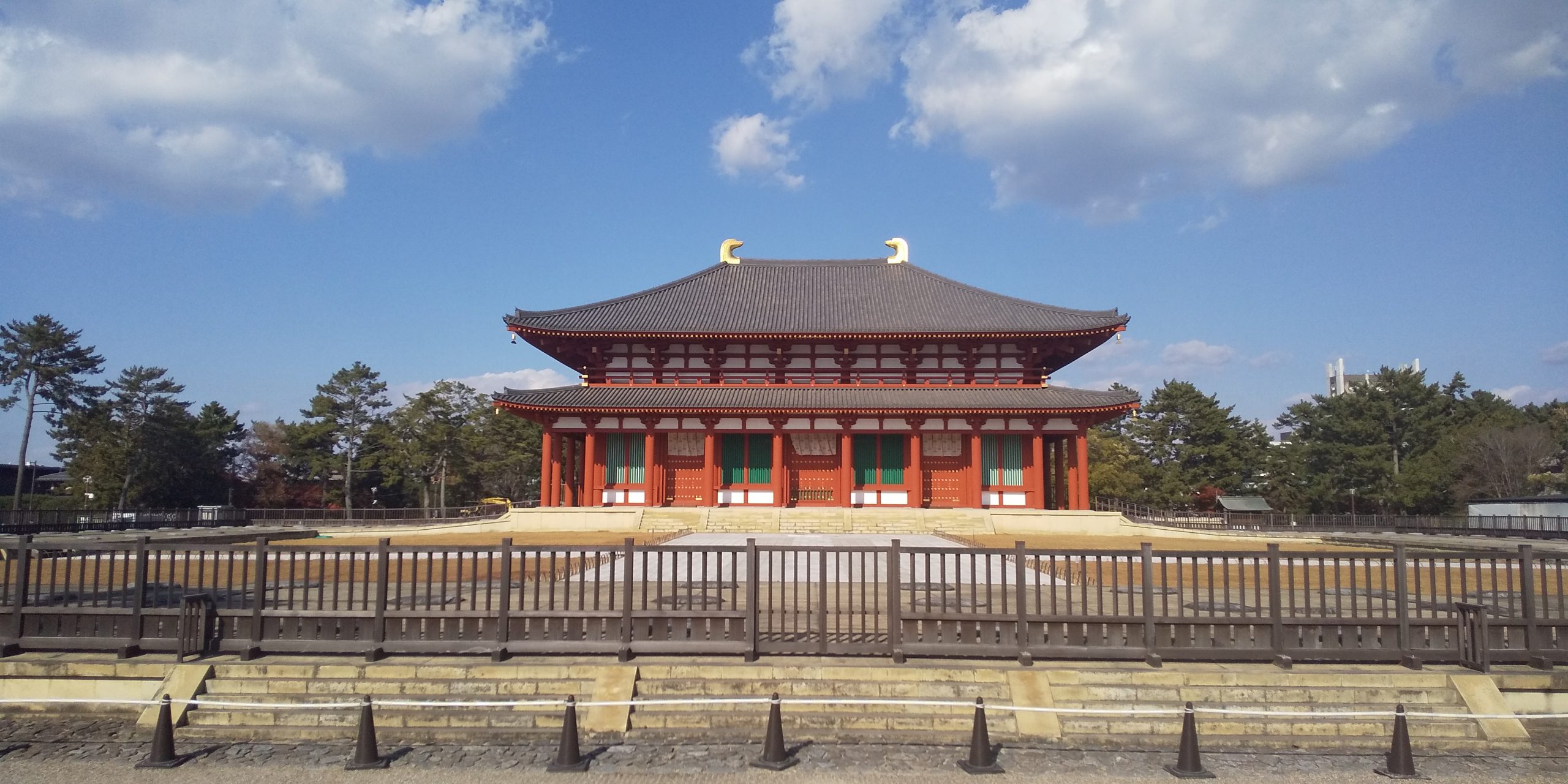
遥か昔のものとは思えない興福寺と東大寺の仏像の表情を見に行きましょう!ゲストハウスを出て右に進むと、商店街を横切った先はもう興福寺の境内です。
Let’s go see the expressions of the Buddha statues at Kofuku-ji and Todai-ji that you won’t believe they were in the distant past! When you leave the guest house and go to the right, you will be in the precincts of Kofuku-ji after crossing the shopping street.
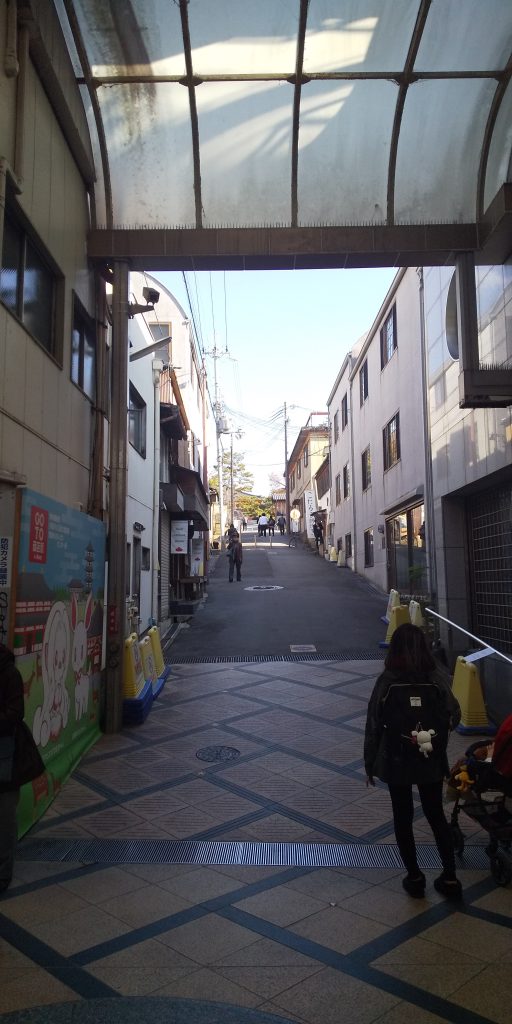
興福寺「阿修羅像」収蔵されている国宝館などは拝観料が必要です。An admission fee is required for the National Treasure Museum, which houses the Kofuku-ji Temple Ashura Statue.(詳しくはコチラClick here for details)
興福寺は、平城遷都の年710年に、西に平城京を見下ろす大地の上に藤原不比等によって建立されました。その後、藤原氏の氏寺として繁栄し、中世には寺でありながら守護職として大和一国を掌握するほど権力を持ちました。それゆえに平氏のような権力者から標的とされ、何度も焼き討ちに遭い主要な建物は消失してしまいましたが、奇跡的にこれらの貴重な仏像が難を逃れました。
Kofuku-ji Temple was built by Fujiwara no Fuhito in 710, the year the capital was moved to Heijo, on the ground overlooking Heijokyo to the west. After that, it prospered as a temple of the Fujiwara clan, and in the Middle Ages, it was a temple, but as a shugoshoku, it had power enough to seize the whole Yamato country. Therefore, it was targeted by powerful people like the Taira clan, and although it was burned down many times and the main building disappeared, these precious Buddha statues miraculously escaped the disaster.
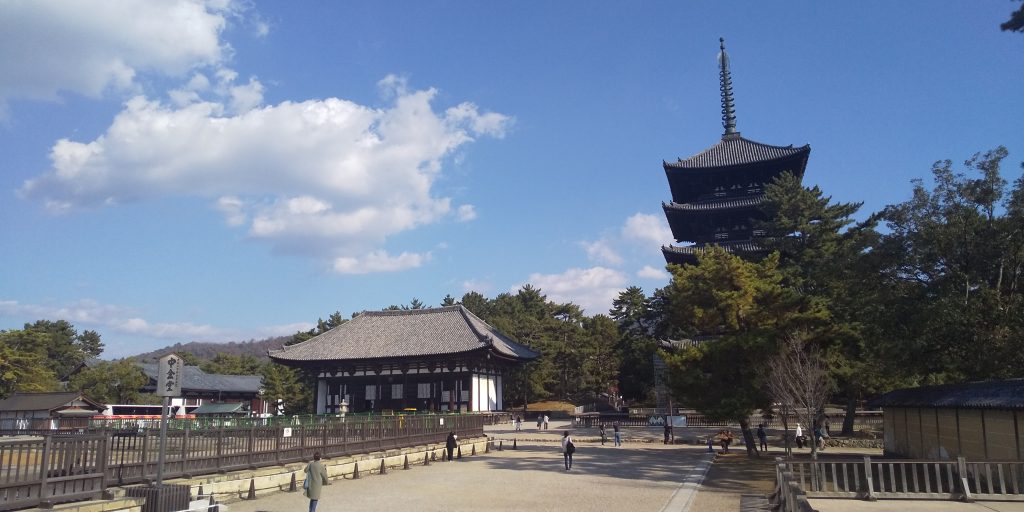
とくに有名な阿修羅像の、この悩ましげな眼差し。西欧のモナリザの微笑みに匹敵する、謎めいた表情だという人もいます。とにかく、1300年前にこのような表情が作られたこと自体が驚きです。平安時代の後期になると浄土思想が流行し、阿弥陀様ばかりが作られるようになってしまいました。しかし、奈良時代は仏教がインドで採り入れた多種多様な神々を受け入れて、たくさんの造形を生み出した、たいへんグローバルな時代だったのです。
This sorrowful gaze of the famous Ashura statue. Some say it’s an enigmatic expression, comparable to the Mona Lisa’s smile in the West. Anyway, it is surprising that such a facial expression was created 1300 years ago. In the latter half of the Heian period, Pure Land Buddhism became popular, and only Amida Buddha came to be created. However, the Nara period was a very global era in which Buddhism adopted a wide variety of gods from India and created many forms.
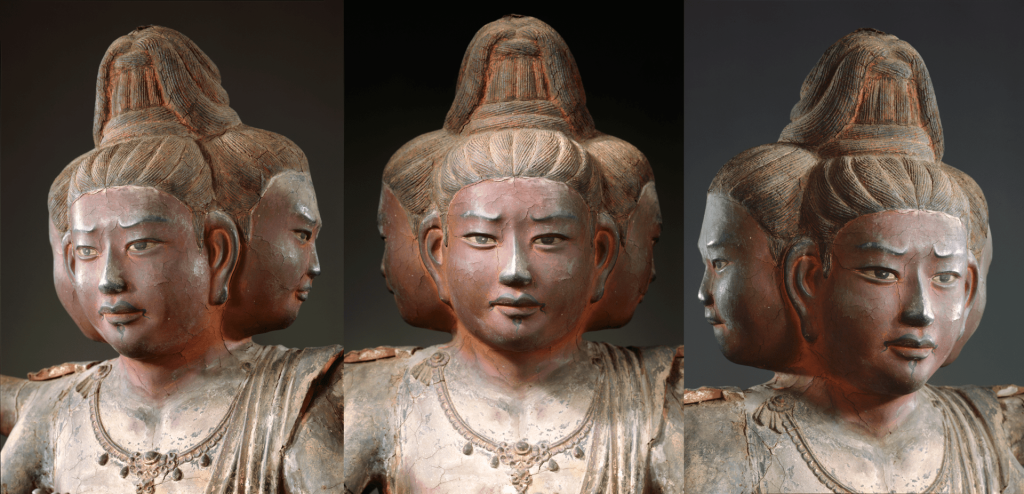
阿修羅のルーツは、古代インドやイランにさかのぼり、インド神話に登場するアスラは英雄神インドラをはじめとする神々デーヴァと闘う話が有名な力強い神々の総称でした。また、アスラに相当するペルシアのアフラは、ゾロアスター教の最高神でしたが、時を経てアスラは魔神としての性格を強めていきました。しかし、仏教に取り入れられてからは仏教を守る守護神として、他の異教の神々と共に八部衆の一人に加えられるようになりました。
The roots of Ashura go back to ancient India and Iran, and asura, which appears in Indian mythology, was a generic term for powerful gods famous for fighting against gods such as the hero god Indra. In addition, the Persian Aphra, which corresponds to the asura, was the supreme god of Zoroastrianism, but over time, the asura strengthened its character as a demon. However, after it was incorporated into Buddhism, it became one of the Hachibushu along with other pagan gods as a guardian deity that protects Buddhism.
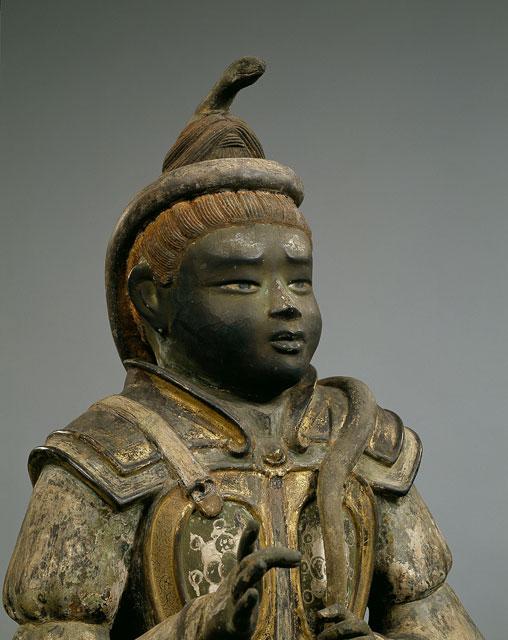
興福寺の仏像群は経典の中の一場面に沿って、懺悔の心を起こしているところが造形されているのではないかと考えられています。阿修羅だけでなく五部浄(天)も沙羯羅(龍に相当)も、憂い顔の少年の姿で、自己の内面を見つめる、まさに思春期のイメージです。懺悔の心を表現するには、もと鬼人であった八部衆にも人間らしさが必要だと仏師が考えたのかもしれません。少年の造形なのは、聖武天皇と光明皇后の間に生まれた期待大の第一皇子が、幼くして亡くなった、その追悼の意味ももめられているとも言われます。
It is believed that the Buddhist statues of Kofuku-ji Temple are sculpted in line with a scene from a sutra, invoking a sense of repentance. Not only Asura, but also Gobujo (heaven) and Sakara (equivalent to dragon) are the image of puberty, looking at the inside of themselves with the appearance of a sad-faced boy. The sculptor may have thought that in order to express the spirit of repentance, the Hachibushu, who were originally demons, needed to be human. It is said that the young boy’s design also reflects the mourning of the son of Emperor Shomu and Empress Komyo, who passed away at an early age.
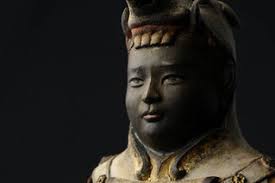
これらの数多くの仏像が収められていた西金堂は、光明皇后が仏教に深く帰依していた亡き母、橘三千代の追悼のために建てられたものです。そのため、ともに悲しんでくれる仏像たちはその目的に適ったものだったのでしょう。特に泣いているようにも感じられる阿修羅像は、拝んでいる自分の心の奥底を引き出すようなところがあります。我々に様々な想像を膨らませるのは、阿修羅像の持つ印影と内面性の深さゆえかもしれません。
The West Golden Hall, where many of these Buddha statues are housed, was built by Empress Komyo in memory of her late mother, Michiyo Tachibana, who was deeply devoted to Buddhism. Therefore, the Buddha statues that mourn with them must have been suitable for that purpose. In particular, the statue of Ashura, which seems to be crying, draws out the depths of one’s heart while worshiping. It may be the impression of the Ashura statue and the depth of its interiority that make us imagine various things.
東大寺はもちろん大仏様ですが、それだけでもありません。他にも面白い貴重な仏像たちがいるのです。(拝観料は大仏殿や法華堂でそれぞれに必要です。Todaiji Temple is of course the Great Buddha, but that’s not all. There are other interesting and valuable Buddha statues. (Admission fees are required for both the Great Buddha Hall and Hokke-do Hall.コチラをご覧ください。Please see here.)
戒壇院「四天王立像」Kaidan-in “Statues of the Four Heavenly Kings”
ここの四天王像の表情を見てください。天平仏の傑作と呼ばれるとおり、今にも動き出しそうに躍動感に溢れ、前方を守っている武器を持った持国天と増長天は、ぎょろりと目を剝いているのに対して、後方の広目天と多聞天は何とも言えない渋い表情をしています。こんな顔した渋い芸能人いますよね。四天王はもともとインド由来の神様で、須弥山という聖なる山で東西南北を守護していたことから、仏法の守護神として信仰を集めるようになったそうです
Look at the facial expressions of the Four Heavenly Kings here. Jikokuten and Zochoten, who are guarding the front with their weapons, are wide-eyed, while Komokuten and Tamonten are in the background. I have a bitter expression that I can not say anything. There are celebrities with faces like this. The four heavenly kings were originally gods of Indian origin, and since they protected the north, south, east, and west of Mt.
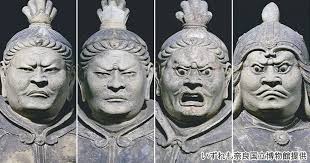
法華堂(三月堂)「不空羂索観音立像」Hokke-do (Sangatsu-do) “Fukaku Kannon Statue”
薄暗いお堂の中に何体もの大きな仏像が立ち並び、天平時代の国宝十二体を含む十六体の仏像がひしめいています。ご本尊の不空羂索観音をはじめ、梵天、帝釈天、阿形・吽形の金剛力士像、四天王は、どれも身の丈3メートルを超え見上げる大きさです。観音菩薩は救いを求める人に応じてさまざまな姿に変身して救済に来ると経典に説かれているので、ヒンドゥー教の多面像の影響なども受けてさまざまな変化観音が生まれました。顔がいくつもあったり、手が何本もあったりすると、なんか気持ち悪~い、と思ってしまうかもしれません。しかし、仏像とは関係ないですが、名作ジキルとハイド氏のように、いろんな顔を持つ人を一つの体で表現しようとしたらこのようになる、そう解釈すればなんか納得です。
Many large Buddha statues stand in a dimly lit hall, and 16 Buddha statues, including 12 national treasures from the Tenpyo period, are crowded together. Starting with the principal deity, Fukukensaku Kannon, the statues of Bonten, Taishakuten, Agata and Ungyo Kongo Rikishi, and the Four Heavenly Kings are all over 3 meters tall. It is said in the sutras that Kannon Bodhisattva transforms into various forms according to the person seeking salvation and comes to the rescue. If there are many faces and many hands, you may feel uncomfortable. However, although it has nothing to do with Buddha statues, if you try to express people with various faces with one body like the masterpiece Jekyll and Mr. Hyde, it will be like this, and it makes sense.
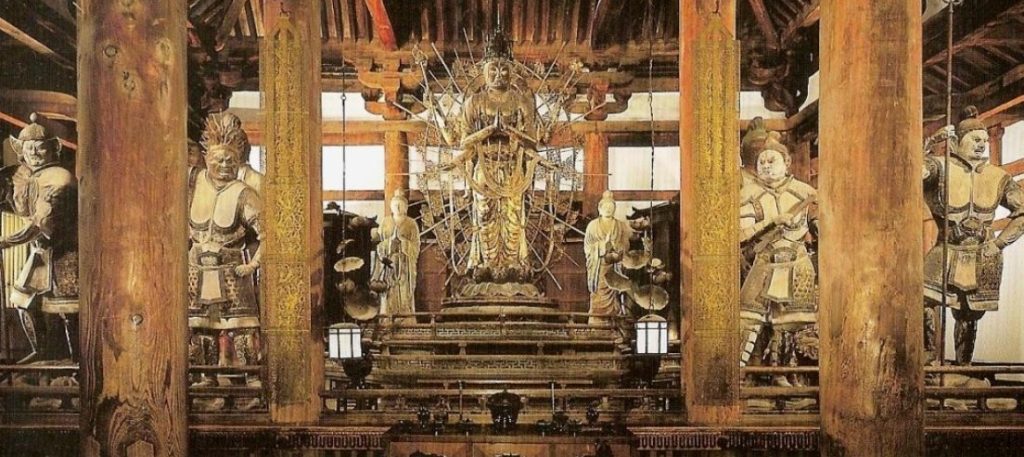
不空羂索観音もその一つで、網と縄で魚や獣を漏れなく掬い取るように、人々をももれなく救ってくださる頼もしい観音様です。
Fukaku Kannon is one of them, and is a reliable Kannon who saves people without exception, just like scooping up fish and animals with nets and ropes.
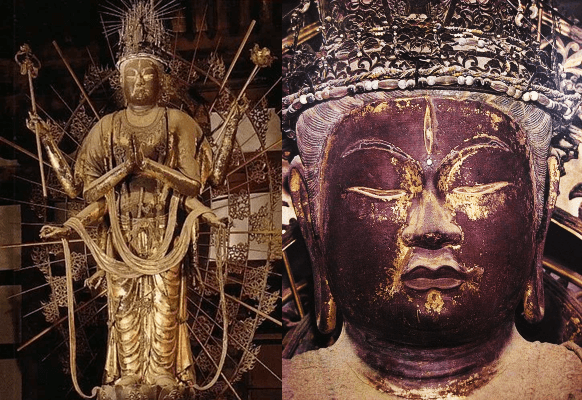
左右に立つのは、宇宙の法則を表すブラフマンを神格化した梵天、古代インド神話の神々の中心であるインドラの帝釈天、これらの巨像は麻布の張り子状の像に木屎漆を盛って形を造る脱活乾漆という技法で造られています。それぞれにインドから伝わった伝説があり、その話を基に想像していろいろな像を造形したのです。
Standing to the left and right are Brahman, the deity of Brahman, who represents the laws of the universe, and Indra, the center of the gods in ancient Indian mythology. It is made with a technique called deactivating dry lacquer. Each of them has a legend transmitted from India, and based on that story, he imagined and created various statues.
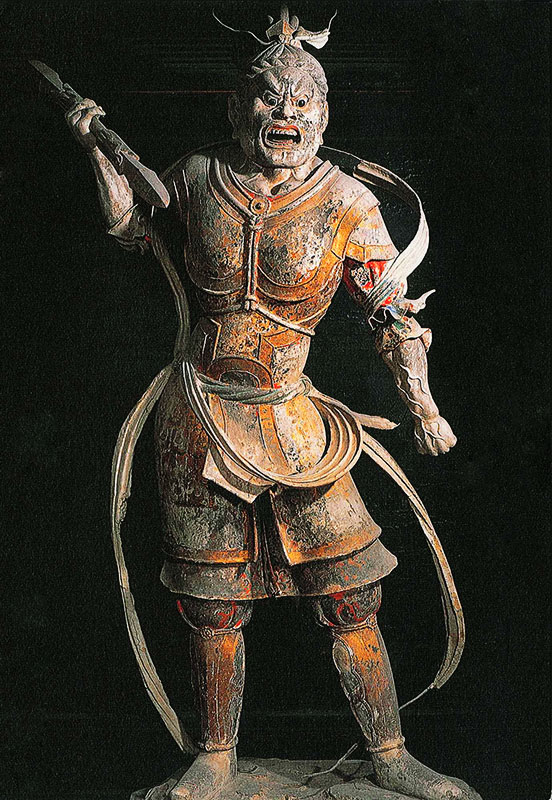
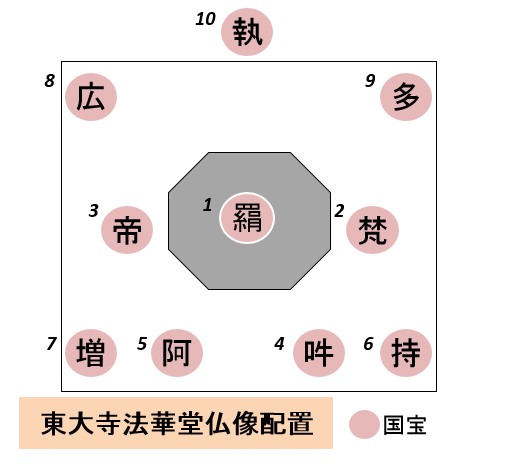
四月堂「千手観音立像」Shigetsudo “Thousand Armed Kannon Statue”
平安時代の木彫りの観音さまで、千手の代わりに四十二本の手を持つのが一般的で、その腕はどれもががっしりと太く、小さなお堂からはみ出していきそうな力強さで頼もしい。ふっくらとしたお顔の表情も明るさに満ちていて、頑張りなさいと励ましてくれているように感じられますか。たくさん作られた手は、より多くの人を救おうとしている意味なんです。決して蛇のようで気持ち絵悪いと思わないようにしましょう。当時の人の切実な思いを必死でつくったものですから、少しでも意味がわかれば、物資が少なく制限の多い時代に、よくこれだけのものをつくったものだと感じるほかありません。
Even the wooden Kannon carved in the Heian period generally has 42 hands instead of 1,000, and each arm is solid and thick. . The expression on her plump face is also full of brightness. Do you feel that she is encouraging you to do your best? A lot of hands made means that you are trying to save more people. Let’s never think like a snake and feel bad. It was created with the utmost effort from the people of the time.
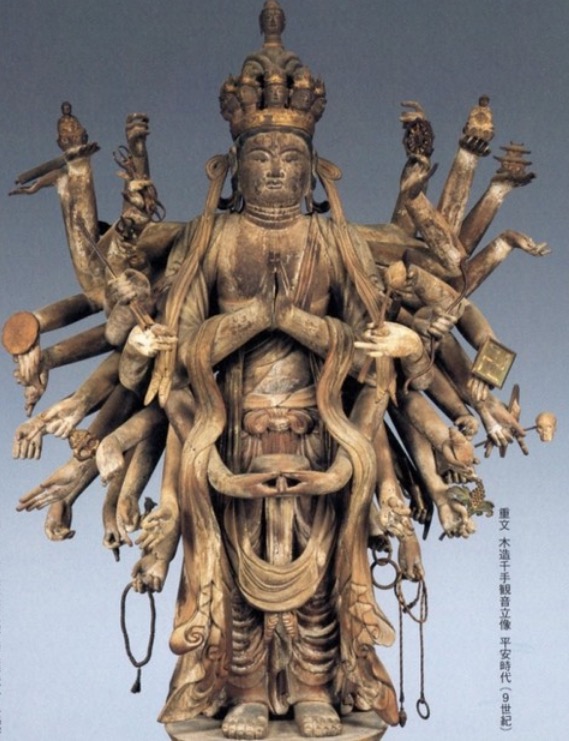
他にもこんなに個性的な像があります!There are other unique images like this!
